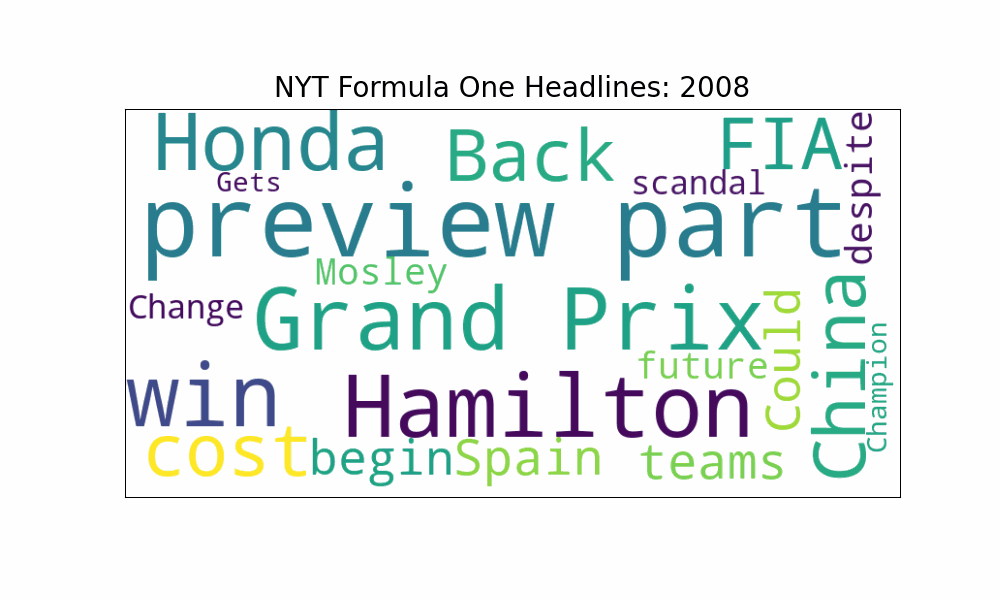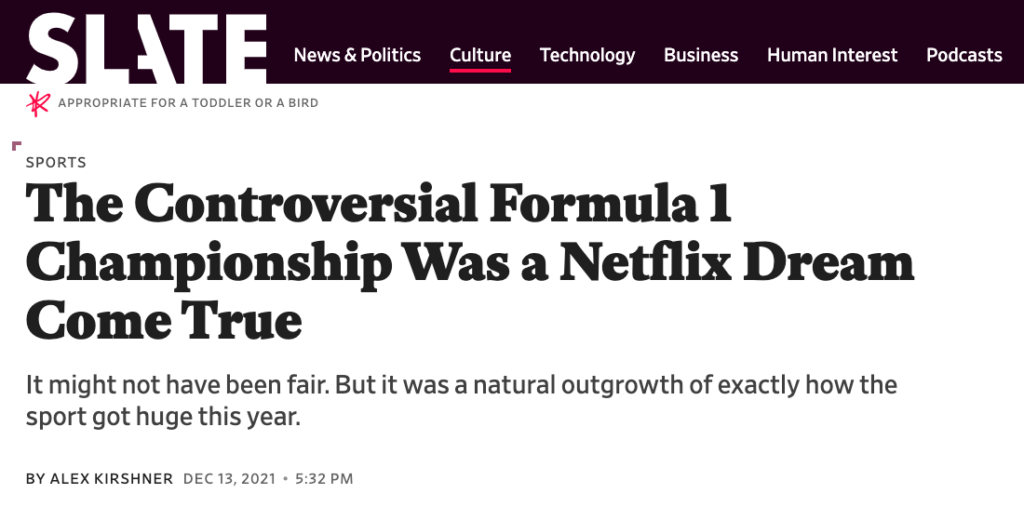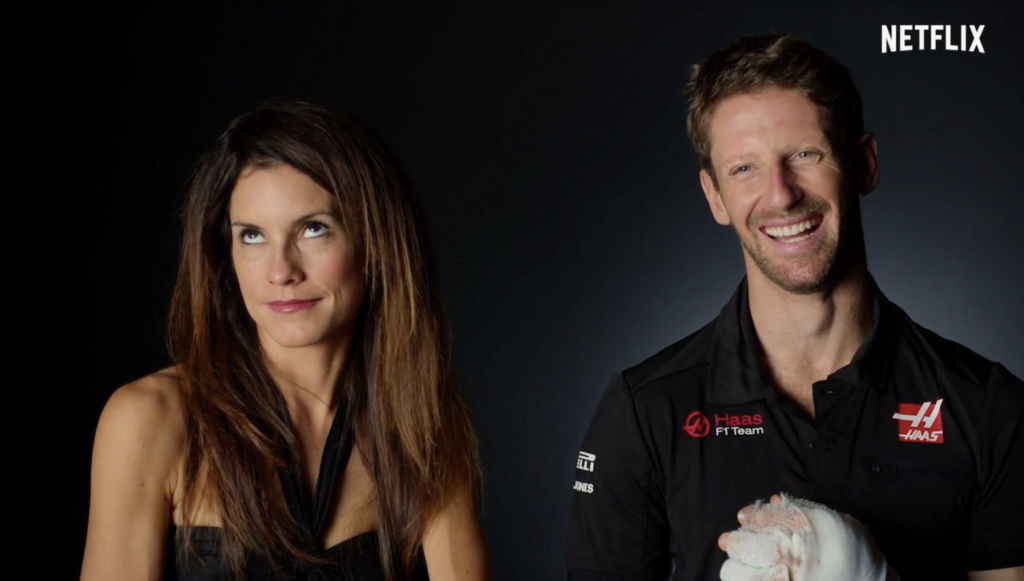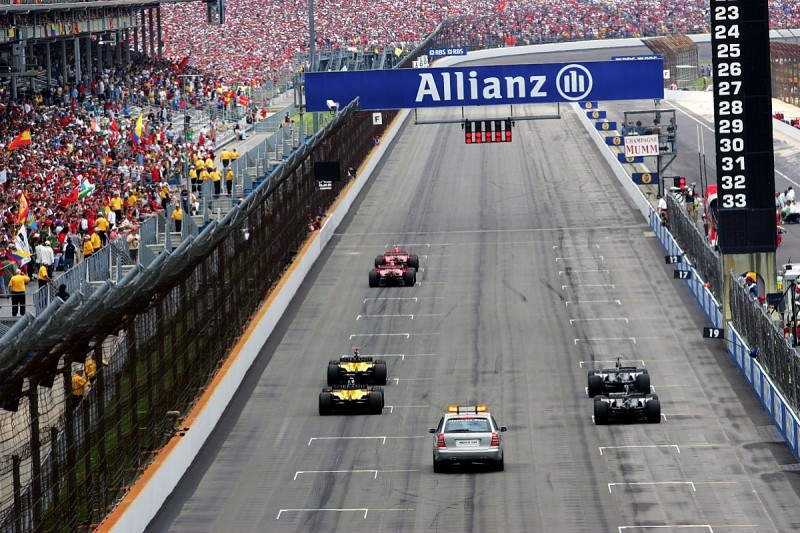Fast cars, big personalities, and a sports league that was bought for $4.7 billion in 2017 and has since then seen an evaluation of 4 times that figure in 2023, an estimated $20 billion. Formula 1 is one of the fastest-growing sports in the US, and it may be coming to your city in the future. What’s behind Formula 1’s growth in the US Market?
In this article, I’m going to cover a brief background of Formula 1’s relationship with the US market and take a look at some data points such as NYT articles, Netflix viewership, subreddit stats, and F1 audience insights.
My F1 Journey
I became a fan of Formula 1 myself around 2016, when I first saw movies that introduced me to the sport such as Senna and Rush (pictured below). I had seen Formula 1 on TV here and there, but I had never been particularly engaged with the sport until I saw the stories behind the drivers. The films showcased the drama, the nerves, and the courage of the drivers, which made the sport feel more real to me and changed my perspective on Formula One.
How do you draw fans to a sport that they or no one in their circles have ever watched? You make a damn good movie about it, that’s how.

Since watching these movies, I have become a pretty dedicated fan to the sport, often wearing my Max Verstappen Red Bull Gear on Race Days (a tribute to my 4 months I spent in the Netherlands, I chose the Dutchman as my favorite driver). Having a “home team” driver in 2016 was a privilege that most Americans did not have, as there were no American drivers at that time.
Despite the absence of any notable American drivers since Michael Andretti in the 1990s, Formula 1 has been on a relentless crusade to break into the US market for many years now.
Formula 1’s Growth in the US Market
Below we’ll start with a high level timeline overview then go into a few other angles of how Formula 1 has tried to capture the US market.

Timeline Overview
MIXED RESULTS 2000-2007 The US Grand Prix races hosted by the Indianapolis Motor Speedway from 2000 to 2007 were marred by controversies, including tire safety issues and the infamous 2005 race where all teams using Michelin tires withdrew, leaving only six cars on the grid. (The 2005 US Grand Prix Controversy)
FLOP 2011 Grand Prix of America: In 2011, plans were announced to hold a Grand Prix of America race in New Jersey in 2013, with views of the Manhattan skyline. However, the race was repeatedly delayed and ultimately cancelled.
SUCCESS 2012 – Present Circuit of the Americas: In 2012, the Circuit of the Americas track opened in Austin, Texas, becoming the first purpose-built F1 facility in the US. It has been hosting the US Grand Prix since then and has become a popular stop on the F1 calendar, including becoming one of Daniel Riccardio’s favorite tracks, one of the biggest stars in Drive to Survive and arguably F1’s biggest personality.
FLOP 2018: The Miami Grand Prix was announced, to be held in 2019, but the race was ultimately cancelled due to F1’s concerns over the proposed circuit being “sub-optimal.”
SUCCESS 2019 – Present Drive to Survive: In 2019, Netflix released a documentary series called “Drive to Survive” which follows the F1 season from the perspective of the teams and drivers. The series has been strongly credited with helping to grow F1’s popularity in the US.
SUCCESS 2022 – Present Miami Grand Prix: In 2021, F1 announced that it had come to an agreement with the Miami Grand Prix organizers, with a GP in Miami starting in 2022. The Miami Grand Prix drew in 240K fans and a huge cast of celebrities such as Michelle Obama, Tom Brady, David Beckham, Michael Jordan, and more.
TO BE DETERMINED 2023 Las Vegas Grand Prix: The Las Vegas Grand Prix was announced in 2022 and is a street circuit Formula One Grand Prix due planned to take place on Saturday, November 18th at 1AM ET and will include iconic parts of Las Vegas including the Las Vegas Strip.
Now that we’ve had a timeline overview of Formula 1’s actions to break into the US since 2000, let’s take a look at one US media news outlet’s coverage of the sport over time, The New York Times.
The NYT Falling In and Out of Love with F1
Formula 1 has always had some traction with the US markets and some attention from US media, including popular news outlets such as The New York Times writing and covering the storylines each season. I wanted to take a look at measuring some of that traction with the US Media, so I took a look at the data available from the NYT API.
Storylines are exciting and vast within the F1 world with its international presence across the globe, 20 driver lineup all with their own fiery personalities, and all the money that goes into competing and advertising in the sport. You can see some of these themes by year / F1 season in the NYT Headline word cloud below. I was able to pull back this data using a Python script and the NYT Article Search API, which you can find more information on here or check out the full code script here.

One thing I noticed while combing through the data is that the NYT really started to take notice of F1 and its storylines around 2006, and then continued keeping strong coverage until starting to drop coverage around 2015. Why did the NYT have an interest in F1 from 2006-2015? Why did they stop covering it?
Taking a look at a few of the top conversations from r/formula1 discussing the “best Formula One Seasons of all time”, I noticed that there were 4 seasons that were consistently mentioned in the post 2000 era: 2007, 2008, 2010, and 2012. Furthermore, if we take a look at the chart below, we can see that F1 was consistently competitive for both the Constructor’s (Team) and Driver’s Championship between 2005-2012. Between 2013-2020, with the exception of a driver’s battle in 2016 and a moderate Ferrari team challenge in 2018, the championship fight was relatively uneventful. Some may argue that this stretch of Formula 1 was quite boring, even the notorious Sir Lewis Hamilton had something to say about the excitement during this period.
So how did that affect the New York Times coverage of the sport? It affected its coverage quite significatly. Generally we can see the inverse relationship where
The Bigger the Points Gap at the end of the season –> The Less Articles the NYT wrote about Formula 1.

But then, we had the 2021 Season that changed everything. One Race, One Lap determined it all.
A Pivotal Moment: The 2021 Driver’s Championship

I will do no justice to describing the entirety and the complexity of the controversial 2021 season ending that enraged, thrilled, and confused Formula 1 Fans at the season ending race in Abu Dhabi. But, what’s important to note here in relation to this analysis, is that the 2021 Driver’s Championship came down to Lewis Hamilton in his Mercedes vs. Max Verstappen in the Red Bull to the Final Race, and even better, the Final Lap. Besides the 2016 Driver’s Championship where Mercedes’ teammates Lewis Hamilton and Nico Rosberg faced off against each other, we hadn’t seen such as a close finish since the brilliant 2012 Season. It had been 9 years since Formula 1 had a real thrill ending to a season, and it sparked a flurry of news coverage and discussion of the controversy into the offseason and even into the 2022 season.
Why did the race go down to the final lap? A late race wreck from a bottom field driver, Nicholas Latifi, and an incredibly controversial ruling from the race director set up Max Verstappen in P2 to battle Lewis Hamilton for the lead for 1 final lap. Max took this opportunity on fresher tires and swiftly but dramatically passed Lewis on just the final lap of the season to unseat Lewis from his 4 years in a row throne of Driver’s Champion.
I’m not often a conspiracy theorist, but this was an Oscar worthy ending that only came to fruition due to a highly questionable decision from an experienced race director, that was later labeled as clear human error. Did F1’s new owners have anything to do with it? Hard to say. But what is easy to say, is that 2021 was great for business.

Speaking of those new owners ..
A Change of Plans: Liberty Media Acquires F1 in 2017
During F1’s entertainment drought in 2017, F1 suddenly had a new owner. Liberty Media, a US based media and entertainment company, acquired the sport at a whopping $4.6 billion. Since then, much has changed. Here are some of the main changes for fans within the sport:
- Increased focus on fans: Liberty Media is all about the fans, improving experiences at the races, increasing access to teams and drivers, and improving digital and social media availability.
- Expansion into new markets: adding races to the Asia and US market, the US market most notably with the new Miami race that debuted in 2022 and the Las Vegas race that is set to debut this year in 2023.
- Emphasis on competitive and close racing: Liberty Media introduced new cost control measures such as the budget cap to limit team spending and tighten the field together. Additionally, they’ve introduced some of the most notable regulation changes in the sport’s history starting in 2022 to promote closer and more action packed racing.
Most notably for the US market, Liberty Media did something that changed everything beyond the day-to-day of the sport.

Netflix Releases “Drive to Survive”
It was a lonely period, 2016-2018, watching an odd European sport that frankly no one really cared about in my circles. But in 2019, Netflix’s Drive to Survive hit the market and changed everything.
I’m not going to write a whole article about Drive to Survive, because it could take up the entire story, but I will say that Drive to Survive may have been the exact prescription that previously uninterested but potential USA Formula One fans needed. It was the hook, line, and sinker that got a lot of US fans really excited about F1 racing all the sudden. Sure, it wasn’t 100% representative of the sport, it dramatized many storylines, and it frustrated many veteran fans of the sport who didn’t like seeing F1 Drivers turned into “Real Househusbands of Formula 1” characters, but it was a fun show to watch and the drivers and the races all the sudden had character and personality. It took Formula 1 races from black and white cars turning on a track to colorful storylines and drama that no one wanted to miss.

It’s hard to prove that Drive to Survive certainly caused all or most of Formula 1’s growth in the US market, but there is some strong correlation. For instance, followers across Formula One social media platforms were up 40% to 49.1 million and video views were up 50% to 7 billion in 2021, according to F1. Additionally, the same article mentions a rise in season cumulative audience in the USA of +58% YoY.
In further evidence of Drive to Survive’s influence on the sport, other sports such as Tennis (Break Point) and Golf (Full Swing) have taken note of the effect of Drive to Survive and made their own drama-series of their own. Additionally, the NFL is soon to come out with Quarterback.

Even if Drive to Survive wasn’t actually the primary catalyst to the growth in Formula 1 in the US market, it has certainly fooled many of the other major sports into thinking so.
Looking Ahead: F1 is set to keep growing the US market in 2023

The Good: Racing seems to be more competitive then ever
More and more Americans are becoming interested in Formula 1, as we can see from the various growth metrics above such as the actual views per race by the US market, 1st week release views of Drive to Survive and google search interest, and also participation in the Formula 1 subreddit.
Now that 2023 is the 2nd year into the new design regulations and the 3rd year of the cost cap financial regulations, we should hopefully be seeing some closer racing, more frequent overtakes, and a more balanced field overall. Testing and practice results leading into the Bahrain GP showed some promising signs for this close wheel racing, including a tighter spread between P1 and P10 than seen in the past 5 years of racing.
Additionally, a previously mid/bottom field team, Aston Martin, may be able to compete with the top 3 teams this year (Red Bull, Mercedes, Ferrari). This optimism and faith showed evidence when Fernando Alonso put his AMR23 into a podium 3rd place during the Bahrain GP, a significant victory for an Aston Martin team that finished 7th out of 10 in the Constructor’s Championship in 2022.
The fact that an F1 team who’s highest finish was P6 the entire year of 2022 has now earned a podium in just the first race of the 2023 season is great evidence that F1’s new regulations may be leveling the playing field as intended. But there are some skeptics.
The Bad: Will Red Bull ruin that plan?
Based on what we saw during the 1st weekend, many are saying that its likely that Max Verstappen and Red Bull will pull away from the pack this year. George Russel, Mercedes Driver, went as far as saying he expects Red Bull to win every race this year.
Red Bull shows every sign of being so much stronger than the rest of the field. For someone just entering the sport, this may be viewed as quite boring. And that’s not good for Liberty Media’s business. Will we see a 2013-2020 style juggernaut season? Or we will see something closer to the 2007-2012 era, or even something as dramatic as the 2021 season ending.

A New Era of F1?
I’m cautiously optimistic that 2023 may prove to be a competitive and storyline filled year for the sport. And I truly do hope that one of other teams can push and challenge the new villain of Formula 1, Red Bull Racing, during the championship fight to keep the storylines interesting and cause even more people to fall in love with F1. Liberty Media has taken Formula 1 to new heights, through both smart business moves and regulation changes to get the drivers to bunch up and race each other more, and only time will tell if that will pay off for the 2023 season or if close racing fans will have to continue their wait.
Formula 1 has one foot in the door in the US market and some serious investments made with the Las Vegas race launching this year, which has been grabbing some tear jerking ticket price attention from US fans. I believe F1 is in a better position than it ever has been before. I do think that having a competitive and engaging 2023 race season will be important for the continued growth in the US market for the business.
I personally hope that the sport does not see yet again the era of a single team juggernaut like Mercedes had in 2013-2020 and we can see some close battles again like the exciting 2007-2012 era. But in terms of single teams dominating eras, to some fans, that’s just part of the sport.
What do you think? Leave your comments below or reach out to continue the conversation!
Thank you for reading! If you have any feedback or thoughts, would love to continue the conversation — add a comment below. Or, you can reach me directly at @JacksonBurton11 on Twitter or email me at jacksonburton04@gmail.com.
If you would like to see the code I used to pull back data from the NYT and build the animated world cloud, I have provided a link to that code below. The rest was done using Tableau Public.
GitHub Link to code used for NYT data
If you’d like to stay up to date on any future Off Road Analyst posts, sign up below!
Sources
Listing sources used in data visualizations and not previously linked in article below

I choked up $2000 for two T15 tix & parking for Austin but that’s my limit. And I live in Austin. I’m used to getting up for a six am race or staying up until midnight so my TV habits won’t change. But F1 is starting to over price itself. And don’t get me started on Ticketmaster! Or do.
Wow! Yeah $2000 + lodging and travel for someone who doesn’t live in Austin would probably push you at least $4000 I would think.
What was the Ticketmaster up charge? 10-20% or more?